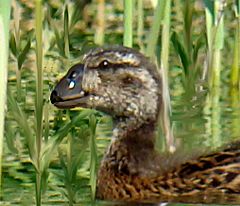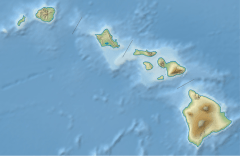Makauwahi Cave facts for kids

Reconstruction of the Turtle-jawed moa-nalo, Chelychelynechen quassus
|
|
| Location | south coast of Kauaʻi island, Māhāʻulepū Valley |
|---|---|
| Region | Hawaii |
| Coordinates | 21°53′18″N 159°25′8″W / 21.88833°N 159.41889°W |
The Makauwahi Cave is the biggest limestone cave in Hawaii. It's found on the south coast of Kauaʻi island. The cave is in the Māhāʻulepū Valley, close to Māhāʻulepū Beach. It's super important for studying ancient life (paleoecology) and human history (archaeology). You get into the cave through a sinkhole. Experts say it might be the richest place for fossils in all of the Hawaiian Islands. Some even say it's the best in the whole Pacific Ocean region!
Contents
Discovering Makauwahi Cave
People on Kauaʻi knew about the cave for a long time. Ancient Hawaiians even used it as a burial site. But its amazing fossil value was first found in 1992. David Burney, Lida Pigott Burney, Helen F. James, and Storrs L. Olson discovered it. They found the cave's entrance while looking for fossils on Kauaʻi's south coast.
The cave's old Hawaiian name, Makauwahi, means "smoke eye." A local archaeologist, William Pila Kikuchi, rediscovered this name in 2000. He found it in a high school student's essay written over a hundred years ago.
Protecting the Cave Area
In 2004, the Burneys leased the land around the cave. This area is now the Makauwahi Cave Reserve. It covers about 17 hectares (42 acres). The land is being restored because it was once used for growing sugarcane and corn. After farming stopped, many weeds took over. Now, people are planting native Hawaiian plants there. This includes local Pritchardia palms, which are special to the area.
What Makes Makauwahi Cave Special
This cave is unique in the Hawaiian Islands. It has a sinkhole that formed a paleolake inside a huge cave system. This system is made of eolianite limestone. The paleolake holds nearly 10,000 years of sediments. These sediments are like layers of history.
Since the cave was found, scientists have dug up many things. They found pollen, seeds, tiny organisms called diatoms, and shells. They also found old Polynesian tools and thousands of bird and fish bones.
Clues from the Past
The things found in the cave tell us a lot. They show what Hawaii was like before humans arrived. They also show how much the environment changed after people came. The first Polynesians arrived, and later, Europeans and Asians. They brought many new plants and animals that were not native.
The cave shows that many native birds became extinct because of these changes. It also proved that some plants, like Kou (Cordia subcordata) and Hala (Pandanus tectorius), were already in Hawaii. People used to think Polynesians brought these plants.
Amazing Extinct Animals
About 40 different kinds of bird bones have been found in the cave. Half of these bird species are now extinct. This means they no longer exist anywhere.
Some exciting new discoveries include the turtle-jawed moa-nalo (Chelychelynechen quassus). There's also the blind and flightless Kaua'i mole duck (Talpanas lippa). Another find is the Kauaʻi palila (Loxioides kikuichi).
The Kauaʻi cave wolf spider is also called the "blind spider." This spider is only found in Makauwahi Cave. It also lives in a few other lava tubes nearby.


